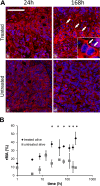Upregulation of heat shock proteins and the promotion of damage-associated molecular pattern signals in a colorectal cancer model by modulated electrohyperthermia
- PMID: 24973890
- PMCID: PMC4255246
- DOI: 10.1007/s12192-014-0523-6
Upregulation of heat shock proteins and the promotion of damage-associated molecular pattern signals in a colorectal cancer model by modulated electrohyperthermia
Abstract
In modulated electrohyperthermia (mEHT) the enrichment of electric field and the concomitant heat can selectively induce cell death in malignant tumors as a result of elevated glycolysis, lactate production (Warburg effect), and reduced electric impedance in cancer compared to normal tissues. Earlier, we showed in HT29 colorectal cancer xenografts that the mEHT-provoked programmed cell death was dominantly caspase independent and driven by apoptosis inducing factor activation. Using this model here, we studied the mEHT-related cell stress 0-, 1-, 4-, 8-, 14-, 24-, 48-, 72-, 120-, 168- and 216-h post-treatment by focusing on damage-associated molecular pattern (DAMP) signals. Significant cell death response upon mEHT treatment was accompanied by the early upregulation (4-h post-treatment) of heat shock protein (Hsp70 and Hsp90) mRNA levels. In situ, the treatment resulted in spatiotemporal occurrence of a DAMP protein signal sequence featured by the significant cytoplasmic to cell membrane translocation of calreticulin at 4 h, Hsp70 between 14 and 24 h and Hsp90 between 24- and 216-h post-treatment. The release of high-mobility group box1 protein (HMGB1) from tumor cell nuclei from 24-h post-treatment and its clearance from tumor cells by 48 h was also detected. Our results suggest that mEHT treatment can induce a DAMP-related signal sequence in colorectal cancer xenografts that may be relevant for promoting immunological cell death response, which need to be further tested in immune-competent animals.
Figures





Similar articles
-
DNA fragmentation and caspase-independent programmed cell death by modulated electrohyperthermia.Strahlenther Onkol. 2014 Sep;190(9):815-22. doi: 10.1007/s00066-014-0617-1. Epub 2014 Feb 22. Strahlenther Onkol. 2014. PMID: 24562547
-
Modulated electro-hyperthermia induced loco-regional and systemic tumor destruction in colorectal cancer allografts.J Cancer. 2018 Jan 1;9(1):41-53. doi: 10.7150/jca.21520. eCollection 2018. J Cancer. 2018. PMID: 29290768 Free PMC article.
-
Modulated electro-hyperthermia induced p53 driven apoptosis and cell cycle arrest additively support doxorubicin chemotherapy of colorectal cancer in vitro.Cancer Med. 2019 Aug;8(9):4292-4303. doi: 10.1002/cam4.2330. Epub 2019 Jun 10. Cancer Med. 2019. PMID: 31183995 Free PMC article.
-
Modulated Electro-Hyperthermia-Induced Tumor Damage Mechanisms Revealed in Cancer Models.Int J Mol Sci. 2020 Aug 29;21(17):6270. doi: 10.3390/ijms21176270. Int J Mol Sci. 2020. PMID: 32872532 Free PMC article. Review.
-
Heat shock proteins at the crossroads between cancer and Alzheimer's disease.Biomed Res Int. 2014;2014:239164. doi: 10.1155/2014/239164. Epub 2014 Jul 24. Biomed Res Int. 2014. PMID: 25147790 Free PMC article. Review.
Cited by
-
Quo Vadis Oncological Hyperthermia (2020)?Front Oncol. 2020 Sep 4;10:1690. doi: 10.3389/fonc.2020.01690. eCollection 2020. Front Oncol. 2020. PMID: 33014841 Free PMC article. Review.
-
The Synergy of Thermal and Non-Thermal Effects in Hyperthermic Oncology.Cancers (Basel). 2024 Nov 21;16(23):3908. doi: 10.3390/cancers16233908. Cancers (Basel). 2024. PMID: 39682096 Free PMC article. Review.
-
Digoxin-Mediated Inhibition of Potential Hypoxia-Related Angiogenic Repair in Modulated Electro-Hyperthermia (mEHT)-Treated Murine Triple-Negative Breast Cancer Model.ACS Pharmacol Transl Sci. 2024 Jan 9;7(2):456-466. doi: 10.1021/acsptsci.3c00296. eCollection 2024 Feb 9. ACS Pharmacol Transl Sci. 2024. PMID: 38357275 Free PMC article.
-
Heterogeneous Heat Absorption Is Complementary to Radiotherapy.Cancers (Basel). 2022 Feb 11;14(4):901. doi: 10.3390/cancers14040901. Cancers (Basel). 2022. PMID: 35205649 Free PMC article. Review.
-
Relationship between Energy Dosage and Apoptotic Cell Death by Modulated Electro-Hyperthermia.Sci Rep. 2020 Jun 2;10(1):8936. doi: 10.1038/s41598-020-65823-2. Sci Rep. 2020. PMID: 32488092 Free PMC article.
References
Publication types
MeSH terms
Substances
LinkOut - more resources
Full Text Sources
Other Literature Sources
Medical
Molecular Biology Databases
Research Materials

